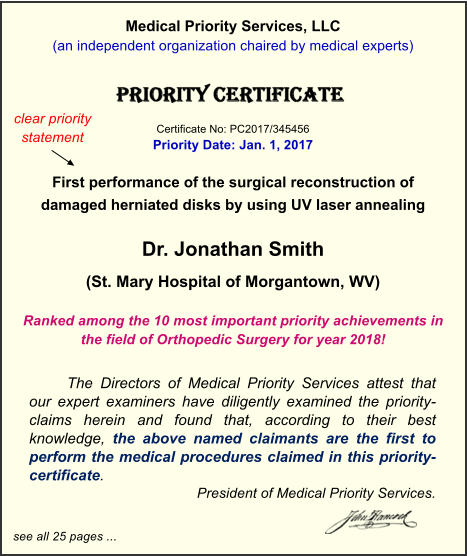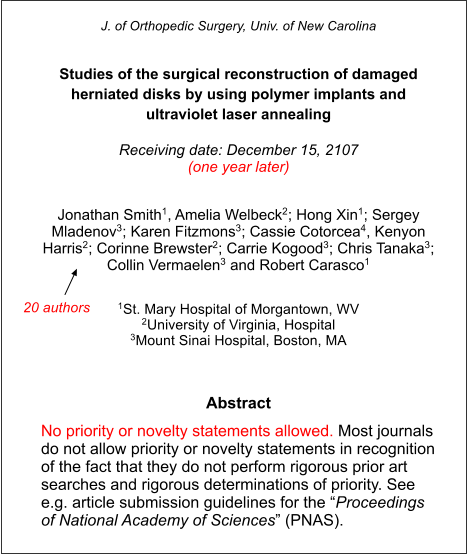Priority-Services herein
vs.
Publication in Academic Journals
Securing priority for ideas & discoveries via:
Publishing in traditional journals:
(1). Slow & cumbersome - it takes months to write
an article (requires rigorous supporting arguments /
experimental support / collaboration with others / data /
analysis / citations - major headache!!)
(2). Secures priority months or years after conception
of ideas & discoveries.
(3). Biased against less influential innovators &
creators (less accessible to less influential innovators)
(4). Journal articles do NOT make a precise / strong
statement of priority
Using academic-priority-services
(1). Easy & fast - it takes 30 minutes to write & publish a
priority-claim (short & concise statement - does not require
supporting arguments / studies / citations / experimental data
& data analysis, etc.)
(2). Certain to secure priority within hours from conception of
ideas & discoveries
(3). Fair & easily accessible to everybody in the world (no
matter who you are and where are you from)
(4). Strong & precise priority statement (strong and hard to
ignore evidence)
... designed to correct the shortcomings of journals



1
Priority-services are faster, easier & safer at securing priority
Consider a junior scientist (working for a less-known university) who just found a likely explanation for a misunderstood and
important phenomenon in cancer cell multiplication. The scientist proposes a certain molecular mechanism explaining the
phenomenon (idea conceived on Jan. 1, 2017).
Publishing article in journals
Jan 1, 2017 – junior scientist starts writing article
Jan 10 – junior scientist sends article draft to journal-1 & journal-2
(top journals)
April 20 – reviewer of journal-1 asks for more information and
citations (answer sent quickly)
May 15 – journal-2 rejects article (citing limited publication space)
June 20 – reviewer of journal-1 dissatisfied with the lack of
experimental data (answer sent – experiment is expensive, grant
application is long, junior scientist does not have a laboratory)
Sept 5 – journal-1 rejects the article because lack of experimental
support for the proposed mechanism
Sept 6 – March 5, 2018 – scientist discloses idea to his manager
and co-workers. After prolonged discussions, preliminary experiment
is performed in collaboration with another lab. Scientist re-writes
article (20 co-authors) and submits article to Journal-3.
July 20, 2018 – articles is published in Journal-3 (receiving date on
the article is March 5, 2018).
(publishing in journals can be a major headache - journals do not
publish “ideas” or “explanations” - but require complete studies)
On the face of the article
•
Receiving date: March 5, 2018 (16 months later!)
•
Authors – 20 co-authors (not specified the contribution of each
co-author). Public assumes that the most famous person on the
article is the one who came with the original idea.
•
30 pages including: background, description, data, commentary
but no explicit statement of priority
Using academic-priority-services
Jan 1, 2017 – scientist uploads on the Personal-Priority-Account:
description of the explanation and mechanism (e.g. voice recording,
written document) – supporting evidence saved the same day!
Jan 10 – scientist publishes formal-priority-claims on the List of
priority-claims for Cancer Biology (clear & unequivocal assertion
of priority published on the List). Scientists does not need
permission from anybody and is guaranteed that his claims will be
published. (10 days from conception!!)
Jan 10 - Dec 20 – competitors in other universities view his formal-
priority-claims and submit comments
Dec 20 – MD applies for priority-certificate (optional step)
March 20, 2018 – a priority-certificate is obtained and published on
the “List of priority-certificates in Cancer Biology”
On the face of the priority-certificate:
•
priority date: Jan 1, 2017 (day of conception!!)
•
Claimants – the scientist who actually came with the ideas
•
Clear, unequivocal & explicit statement of priority (via formal
priority claims) identifying what is NEW

3
A service for the less-influential innovators
Publishing articles in academic journals
(1). Publishing in journals is:
•
heavily biased in favor of established and well-known
institutions and professionals
•
biased against less-influential innovators
(2). Your article is NOT likely to be published if:
•
you are NOT employed by a well-known university or research
institution (e.g. you are employed by a small university in
Romania, Indonesia, Brazil or Egypt; you are a high school
teacher or a clerk; you are unemployed)
•
you do not have an advanced degree (masters or Ph.D.)
•
you are a student and your professor does not support you
•
you are an independent innovator
(3). There is no right to have your article published by a journal
even if your article discloses new & valuable ideas. The editor can
refuse to publish your article because: there is limited publication
space” or “other submissions are of more interest to the readers”.
publishing in journals >> major headache!
Using academic-priority-services
(a service for the people frustrated with journals)
(1). Everybody treated by the same uniform standards & rules.
(whether you are a Harvard Professor or a student of an unknown
university in Indonesia / Romania / Bolivia or Algeria).
•
all submissions are processed under “anonymous name”
(2). LEGALLY ENTITLED to have your formal-priority-claims
published on the List of priority-claims for the specific field (no
matter who you are and where you are from):
•
no publication limits (as in the case of journals)
•
no requirements for citations, background, experimental
results, data etc.
•
no matter how “not interesting” someone thinks your claim is
(3). LEGALLY ENTITLED to receive a priority-certificate (if your
ideas are novel) - similar to “invention patents”
•
no matter whether the examiner finds that your priority-claims
are not interesting
using priority-services >> “peace of mind”
Less-influential innovators:
•
Innovators from less developed regions & countries of the world (small university in Romania, India, Indonesia, Bolivia, Egypt, Kenya, etc.)
•
Independent innovators (not associated with prestigious research institutions & universities)
•
Less-influential professionals (interns, temporary employees, junior employees, nurses, aids, )
•
Less-influential scientists - individuals not having the proper educational background, technicians, graduate students, junior scientists, etc.
•
Individuals who generally do not have a say in what is happening in the world




4
Formal-priority-claims & priority-certificates
•
A formal-priority-claim is directed to a SINGLE specific idea,
explanation, hypothesis or discovery (short & concise) for
which priority is claimed (novelty is required).
•
Formal-priority-claims do not require experimental support /
rigorous analysis / data / arguments / citations as in the case of
journal articles (priority-certificates do require support).
•
Primary role is “securing priority & recognition for innovators”
•
it takes 30 minutes to write & publish a priority-claim
Journal articles
•
Articles disclose relatively complete & rigorous studies.
An article discloses MULTIPLE ideas, explanations,
discoveries and commentaries.
•
Articles require rigorous supporting arguments / citations /
theoretical background / experimental support / rigorous
data analysis / simulations, etc.
•
Primary role is “informing the public”
•
it takes months to write an article (major headache!!)
Priority-services are NOT replacing publication in journals!!
(priority-services are supplementing journal publication)
Differences between the roles played by “journal articles” and “priority-claims / priority-certificates”:



Journal articles
1.
No prior art searches and no rigorous determination of priority
re any of article’s features (explanations, ideas, procedures).
2.
No formal claims (as the ones concluding patents) pointing
out with specificity the NEW features. The NEW features are
mixed (buried) into 40 pages of description, data,
experimental procedures.
3.
Journals do not allow “statements of priority or novelty”
(see PNAS).
4.
Contribution of each co-author NOT specified. Article may
have 30 co-authors but only one may have contributed NEW
matter to the procedure.
5.
Earliest priority date = “article receiving date” (usually
months or years from the conception or performance)
Conclusion:
Weak & imprecise statement about authors:
It can NOT be concluded (with a reasonable degree of certainty)
that a person named on an article is the first to propose an idea or
the first to perform a medical procedure disclosed by the article.
Priority-certificates
1.
Rigorous prior-art searches and determination of priority for
the claimed features
2.
Includes formal-priority-claims (similar to invention patents)
identifying concisely and precisely the NEW features. NEW
features clearly separated from ancillary info such as: data,
background, experiments etc.
3.
Clear statement of priority – posted on the face of the
certificate (via formal-priority-claims).
4.
Contribution of each claimant clearly specified – only
claimants contributing NEW matter are included (similar to the
inventors on patents)
5.
Earliest priority date = “personal-priority-account date”
(within minutes or hours from conception or performance)
Conclusion:
Strong & precise statement about claimants:
Priority-certificate designed specifically to certify (with high degree
of certainty) that the claimant is the first to propose an idea or the
first to perform a medical procedure claimed by the certificate.
Dr. Smith has received 5 priority-certificates Dr. Smith has achieved 5 medical-firsts
Dr. Smith has published 150 articles ?? medical-firsts (may be 0 … may be 5 … may be 20)





Priority-certificates make a stronger & more precise statement about innovators
•
Meaning of certificates clear & easy to understand by
patients (similar to patent letters on the wall)
•
Patients likely to remember the certificate
•
Meaning of article is vague (lots of co-authors, many
institutions, no priority statement)
•
Patients unlikely to remember the article
In the office of a Medical Doctor (on the wall)
Pages 440-445 in the Oxford published article (Priority certificates: proposal for non-intrusive forms of IP, by Comanescu & Hyndman)
explain in detail the advantages of using priority-certificates over journal publication. Please see sections:
1.
“Tools to enable scientists and innovators to secure recognition for discoveries and ideas” (pg. 440-442)
2.
“How priority certificates help scientists and innovators secure credit for their ideas and discoveries” (pg. 442-443)
3.
“The superiority of priority certificates over journal articles in securing priority” (pg. 443-445)
Further analysis:
o
Advantages of priority-services (detailed analysis)
o
Article draft (raw draft - hope to complete it shortly)
1
2
5
6


Copyright
©
Jerry Comanescu, 2015
Contact: Jerry Comanescu, comanescu68@gmail.com, Tel: 202-754-2064
World Registry of New Ideas

